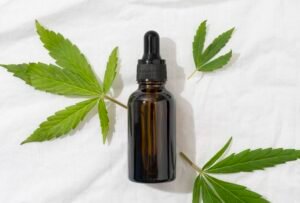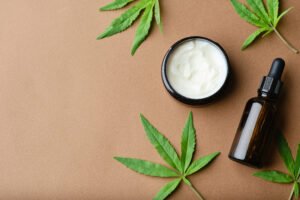Experiencing marijuana-induced anxiety can be a perplexing paradox, especially when many medical marijuana users turn to cannabis to alleviate anxiety symptoms. The curious relationship between marijuana and anxiety can be attributed to the intricate workings of the human endocannabinoid system (ECS). The endocannabinoid system is an extensive network of cannabinoid receptors distributed throughout the human body. When this system is activated, it initiates a series of physiological processes that impact various functions, including appetite, pain perception, mood regulation, and memory.
The two primary psychoactive compounds found in medical cannabis products, THC (tetrahydrocannabinol) and CBD (cannabidiol), influence the CB1 receptors of the endocannabinoid system in distinct ways. According to a comprehensive analysis featured in the Spring 2020 edition of CRx online magazine, the CB1 receptors in the brain play a pivotal role in modulating cognitive functions, mood, emotional processing, and anxiety regulation.
Also Read: Cannabis for Celiac Disease
Bonnie Johnson, the author of the CRx article and the director of science at Goodfeeding, delves into the complex question of whether medical marijuana heightens or alleviates anxiety. Interestingly, her conclusion is that it can do both: increase and decrease anxiety.
The key to understanding this balance lies in the level of stimulation the CB1 receptors in the brain receive:
- Mild THC Signaling: When THC molecules gently bind to CB1 receptors, they induce anxiolytic effects, which essentially means they reduce anxiety. This can lead to feelings of relaxation and relief.
- Intense THC Signaling: On the other hand, when there is a surge of THC molecules attaching to the CB1 receptors, it can trigger anxiogenic effects, amplifying anxiety. This typically occurs with higher doses of THC and can lead to feelings of unease and heightened anxiety.
A crucial takeaway is that lower doses of THC are more likely to diminish anxiety, while higher doses can intensify it.
Now, let’s consider the role of CBD. Unlike THC, CBD does not directly bind to CB1 receptors; instead, it modulates these receptors, making them less responsive to THC and anandamide, another endocannabinoid. In essence, CBD competes with THC for the same receptor sites. Additionally, CBD reduces anxiety like antidepressants, by modulating serotonin receptors that help regulate mood.
It’s important to note that CBD is generally better tolerated than THC. However, this doesn’t mean you can disregard dosage. Lower doses of CBD, such as 5 mg to 10 mg, can have stimulating effects, while higher doses, typically 50 mg or more, may induce sedation. Monitoring your CBD dosage is particularly important if you are using it as a substitute for sedative medications, like clobazam (Frisum, Urbanol) or alprazolam (Xanax). As you increase your CBD dosage, you may need to reduce the use of these sedatives to avoid unwanted side effects, such as excessive drowsiness or overdose.The detailed scientific explanation provided by CRx magazine underscores the importance of an age-old adage for those new to cannabis: Go low and slow. This approach can help you navigate the intricate interplay between THC, CBD, and your endocannabinoid system, ensuring a more controlled and comfortable experience with cannabis and minimizing the risk of marijuana-induced anxiety, often referred to as Marijuana Paranoia.
How Does Cannabis Cause Paranoia?
The association between cannabis use and marijuana paranoia has long been a topic of discussion. It might seem that individuals who use cannabis are more predisposed to experiencing paranoid thoughts. However, a study published in 2011 in Psychological Medicine delved into the marijuana paranoia rates within England’s general population to shed light on this issue.
The study’s findings revealed that cannabis users were three times more likely to believe that someone was intentionally trying to harm them compared to non-users. Even more notably, the perceived threat of deliberate harm was five times higher among marijuana users. Researchers suggest that the connection between marijuana paranoia and the human endocannabinoid system (ECS) plays a pivotal role. Cannabis contains compounds like THC (tetrahydrocannabinol) that bind to cannabinoid receptors located in various regions of the brain, including the amygdala.
Also Read: Using Marijuana While Pregnant
The amygdala is a crucial part of the brain responsible for regulating responses to fear and associated emotions such as anxiety, paranoia, and stress. When the brain is exposed to an excessive amount of THC, it can lead to overstimulation of the amygdala. The result is a heightened sense of marijuana paranoia, anxiety, and an increased perception of fear.
It’s important to note that CBD (cannabidiol) does not directly bind to the CB receptors in the same way THC does. This is one of the key reasons why CBD is not typically associated with causing marijuana paranoia. So, while cannabis and THC can induce marijuana paranoia, CBD is less likely to do so. In essence, CBD does not significantly contribute to marijuana paranoia, and when used responsibly, it can offer a range of potential benefits without the unwanted side effect of heightened marijuana paranoia.
Managing Marijuana Paranoia: Tips for Overcoming Intense Moments
When you find yourself grappling with marijuana paranoia, it’s important to know how to regain a sense of calm and control. Here are some tips to help you navigate these intense moments:
1. Find a Comfortable Space: According to Dr. James Lathrop from Seattle’s Cannabis City dispensary, one of the best strategies when marijuana paranoia gets too intense is to find a comfortable and familiar place to lay down. Creating a soothing environment can help ease anxious feelings.
2. Consider CBD: Dr. Joe Cohen, a holistic doctor of cannabis medicine, suggests using CBD as a remedy for the unpleasant side effects of excessive THC. CBD can help counteract some of the anxiety and paranoia associated with THC overconsumption.
3. Take a Shower: Taking a refreshing shower can be remarkably effective in restoring a sense of physical comfort and grounding. The sensation of water can provide relief and help you feel more connected to reality.
Also Read: Medical Marijuana for Glaucoma
4. Eat a Snack: Consuming a light snack like a sandwich or a piece of fruit can help balance the effects of THC. This can be especially helpful in slowing down the endocannabinoid tilt-a-whirl and reducing feelings of paranoia.
5. Stay Calm: Remember that the body efficiently processes THC, and you cannot overdose on cannabis alone. Even when you’ve taken a substantial dose, the negative effects typically subside within a few hours or less. Staying calm and patient is key to getting through the experience.
It’s crucial to listen to your body and assess your own needs when dealing with marijuana paranoia. Everyone’s response to THC can vary, so it’s essential to find the coping strategies that work best for you and your individual experience.
Understanding Why Some Experience Marijuana Paranoia After Cannabis Use
Not everyone who uses cannabis experiences marijuana paranoia, but for those who do, the reasons behind it can be multifaceted. Let’s explore the various factors that contribute to the occurrence of marijuana paranoia following cannabis consumption:
1. THC Tolerance and Marijuana Paranoia
THC, the primary intoxicating cannabinoid in cannabis, affects individuals differently. Factors like frequent cannabis use and genetics play a role in determining one’s THC tolerance. Smaller amounts of THC may offer therapeutic benefits, leading to the practice of micro-dosing. However, consuming higher doses of THC increases the risk of adverse effects, including marijuana paranoia. A study published in Drug and Alcohol Dependence in 2017 demonstrated the biphasic effects of THC. Patients who consumed 7.5 mg of THC reported reduced stress during a mock interview, while those who consumed 12.5 mg experienced higher levels of negative emotions under the same conditions. Caution is especially essential when using THC-rich cannabis edibles, which can have high THC concentrations.
2. Genetics and Marijuana Paranoia
Research published in Nature in 2019 examined the impact of marijuana on animals and found that marijuana use could reduce anxiety and enhance relaxation while primarily stimulating the frontal region of the brain. Individuals with higher THC sensitivity in the back portion of the brain are more likely to experience adverse reactions, including marijuana paranoia and anxiety.
Also Read: CBD for Multiple Sclerosis
3. Gender and Marijuana Paranoia
A study published in Drug and Alcohol Dependence in 2014 revealed that higher estrogen levels could increase cannabis sensitivity by nearly 30% and reduce THC tolerance. This suggests that females may be more susceptible to cannabis effects, making them more prone to experiencing marijuana paranoia and anxiety compared to males.
4. Aging, Breeding, and Mood Influence on Marijuana Paranoia
The effects of cannabis can change as we age due to alterations in our endocannabinoid system (ECS) and brain function. Cannabis consumption at 25 may differ significantly from its effects at 45. Environmental factors and mood also influence the impact of cannabis. Stress and anxiety can exacerbate the likelihood of experiencing marijuana paranoia when consuming excessive THC. Moreover, modern cannabis strains have become more potent. Breeders are continually developing strains with high THC content, increasing the risk of adverse effects for some users.
Understanding these factors can help individuals make informed choices when using cannabis to minimize the risk of marijuana paranoia and anxiety. It’s important to use cannabis in moderation, consider individual tolerance, and be mindful of environmental and mood-related factors that can influence the overall experience.
Preventing Marijuana Paranoia: A Guide to Using Cannabis Safely
Cannabis can provide therapeutic benefits for various health conditions, but it’s crucial to understand how to use it safely to prevent marijuana paranoia and anxiety. Here are some key points to consider when using medical marijuana:
1. Start Slow and Gradual: Newcomers to therapeutic marijuana should begin with low doses of cannabis products containing high concentrations of THC. Moving too quickly into high THC doses can increase the risk of a panic attack. It’s essential not to exceed your endocannabinoid system’s capacity to handle THC. As you gain more exposure to different types of cannabis and products, you may gradually increase your THC tolerance.
2. Individual Dosage: The goal should not be to take increasing levels of THC, but to find the THC dosage, along with other cannabinoids and terpenes, that works best for your specific needs. Everyone’s ideal dosage may vary. Experienced cannabis users who are accustomed to vaping or smoking should be aware that these methods may not be directly transferable to other forms of ingestion, such as edibles.
3. Caution with Edibles: Edible cannabis products, in particular, require careful consideration. They can have a much stronger effect, even at low THC doses, because the liver metabolizes THC into the more potent 11-OH-THC. It’s essential to consult with your physician before using marijuana edibles to determine the optimal and safe dose that can address your health condition while regulating mood functions, emotional processing, and anxiety.
4. Follow Medical Recommendations: It’s essential not to exceed the upper limit of THC concentration recommended by your healthcare provider. If you find that cannabis edible does not seem to have an immediate effect, be patient and wait. The therapeutic benefits of medical cannabis for chronic conditions can be subtle and may take time to become noticeable. Avoid the common mistake of assuming that consuming more edibles immediately will enhance the medicinal effects.
Also Read: CBD and THC
Safe and effective cannabis use involves personalized dosing, careful consideration of the ingestion method, and patience. By following these guidelines, individuals can harness the potential benefits of medical marijuana while minimizing the risk of marijuana paranoia and panic attacks. Consulting with a healthcare professional can provide further guidance on using cannabis for specific medical conditions.
FAQ
Q. What is marijuana paranoia, and why does it occur?
A. Marijuana paranoia, often referred to as cannabis-induced paranoia, is a state of heightened anxiety, fear, or unease experienced by some individuals after consuming cannabis. It can result from various factors, including the THC content in cannabis, an individual’s tolerance, genetics, and even their current mood.
Q. Who is more likely to experience marijuana paranoia?
A. While not everyone is prone to marijuana paranoia, some individuals are at a higher risk. Factors such as low THC tolerance, specific genetic predispositions, elevated estrogen levels (more common in females), and a stressful or anxious state of mind can increase the likelihood of experiencing paranoia after cannabis use.
Q. How can I prevent or reduce marijuana paranoia?
A. To prevent or minimize marijuana paranoia, start with low doses of cannabis, especially if you’re a newcomer. Gradually increase your THC intake as you become more accustomed to its effects. Be cautious with edibles, as they can be more potent due to liver metabolism. Consulting a healthcare provider for personalized dosing recommendations is advisable.
Q. Does CBD help alleviate marijuana paranoia?
A. CBD, a non-psychoactive cannabinoid found in cannabis, has shown potential in reducing anxiety and may help mitigate the effects of THC-induced paranoia. Some users report that using CBD alongside THC-containing products can result in a more balanced and relaxed experience.
Q. Can I overdose on cannabis and experience marijuana paranoia?
A. It’s essential to understand that a cannabis overdose, while uncomfortable, is not life-threatening. Most people who consume excessive amounts of cannabis may experience heightened anxiety or paranoia for a few hours, but these effects typically subside with time. Staying well-hydrated and in a calm environment can help alleviate discomfort.
Q. Are there specific strains of cannabis that are less likely to cause marijuana paranoia?
A. Some cannabis strains are bred to have higher CBD-to-THC ratios, which may provide a more balanced and less anxiety-inducing experience. Indica-dominant strains are often associated with relaxation, while sativa-dominant strains may be more uplifting. Experimenting with different strains under the guidance of a healthcare provider may help find one that suits your needs.








